ISC Biology Previous Year Question Paper 2016 Solved for Class 12
(Candidates are allowed additional 15 minutes for only reading the paper. They must NOT start writing during this time.)
- Answer all questions in Part I and six questions in Part II, choosing two questions from each of the three sections A, B and C.
- All working including rough work, should be done on the same sheet as, and adjacent to, the rest of the answer.
- The intended marks for questions or parts of questions are given in brackets [ ].
Part-I (20 Marks)
Question 1.
(a) Give a brief answer for each of the following : [4]
(i) What is central dogma?
(ii) Define cryopreservation.
(iii) What is symbiosis?
(iv) Explain the term perianth.
(b) Each of the following question(s) / statement(s) has four suggested answers. Choose the correct option in each case. [4]
1. The curve showing the amount of light absorbed at each wavelength is :
(i) Action spectrum
(ii) Absoiption spectrum
(iii) Quantum yield
(iv) Quantum requirement
2. After fertilisation, the integuments of an ovule develop into :
(i) Seed
(ii) Seed coat
(iii) Fruit
(iv) Fruit wall
3. Meselson and Stahl’s experiment proved:
(i) Transduction
(ii) Transformation
(iii) DNA is the genetic material
(iv) Disruptive DNA replication
4. The act of expelling the full-term foetus from the uterus is termed as :
(i) Gestation
(ii) Implantation
(iii) Parturition
(iv) Capacitation
(c) Give scientific terms for each of the following: [4]
(i) The smallest unit of DNA which can mutate.
(ii) Type of water absorption by roots where metabolic energy is required.
(iii) Statistical study of human population.
(iv) Multiple effects of a gene on the phenotype of an organism.
(d) Expand the following abbreviations : [4]
(i) rDT
(ii) BAC
(iii) SSBP
(iv) IUCD
(e) Name the scientists who have contributed to the following : [4]
(i) Reverse transcription
(ii) Photorespiration
(iii) Principle of limiting factors
(iv) Photolysis of water
Answer:
(a) (i) The basic belief held by molecular geneticists that the flow of genetic information is unidirectional and occurs from DNA → RNA → Protein.
(ii) Cryopreservation is a technique in which organisms, tissue and cells are preserved and stored at very low temperature of liquid nitrogen (-196°C) for years. They remain viable in frozen state for future use.
(iii) Symbiosis is a beneficial association between members of different species in which both the partners are benefitted.
(iv) Perianth is the term used when the calyx and corolla of the flower are indistinct.
(b)
1. – (ii) Absorption spectrum
2. – (ii) Seed coat
3. – (iii) DNA is the genetic material
4. – (iii) Parturition
(c) (i) Muton
(ii) Active absorption
(iii) Demography
(iv) Pleiotropy
(d) (i) recombinant DNA Technology
(ii) Bacterial Artificial Chromosome
(iii) Single-Strand Binding Protein
(iv) Intra-Uterine Contraceptive Device
(e) (i) Temin and Baltimore
(ii) Dicker and Tio
(iii) Blackman
(iv) Robin Hill
Part-II (50 Marks)
Section-A
(Answer any two questions)
Question 2.
(a) Mention three features of the Neanderthal Man. [3]
(b) Differentiate between connecting link and missing link. [1]
(c) What is adaptive radiation? [1]
Answer:
(a) (i) Brain size 1300-1600 cc.
(ii) Used hides to protect the body
(iii) Buried their dead
(iv) Knew use of fire, lived in caves
(v) Omnivore.
(b) Connecting links are living intermediate forms which possess characters of two groups. Missing links are the transitional or intermediate forms between two groups of organisms which occur only in the fossil state.
(c) Adaptive radiation is the formation of a number of divergent species from a common ancestor with new species adapting to different ecological niches.
Question 3.
(a) Give an account of Lederberg’s replica plating experiment to show the genetic basis of evolution. [3]
(b) Define phylogeny. [1]
(c) What is Founder s effect? [1]
Answer:
(a) Lederberg’s Replica Plating Experiment: Joshua Lederberg and Esther Lederberg, gave an experimental demonstration of genetic basis of adaptation. They performed an experiment on bacteria to demonstrate the genetic basis of a particular adaptation. They obtained a ‘master plate’ of bacterial culture by inoculating a dilute suspension of bacteria on an agar plate. After a certain period, the master plate was found to contain several bacterial colonies. Each colony represented a clone that has originated from a single bacterial cell as a result of repeated divisions. They prepared many replicas of the master plate on new agar plates. After that, they tried to grow bacteria on replica plates with an antibiotic (e.g., penicillin). Most colonies of the master plate failed to grow on replica plates having antibiotic. Only few colonies that could be formed were found to be resistant to penicillin. It means that certain bacteria have acquired an ability to survive and grow in a new environment. This mutant strain of bacteria has adapted.
According to Darwinism, the original suspension of bacterial cells contained few mutant bacteria which had mutant genes that enabled them to survive the effect of penicillin and form colonies.
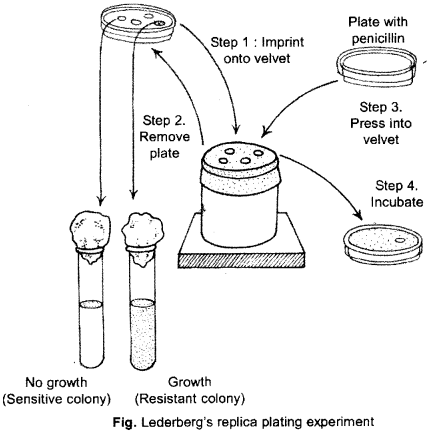
(Sensitive colony) (Resistant colony)
Fig. Lederberg’s replica plating experiment
The Lederberg’s replica plating experiment provided a support to Darwinism is that the adaptation in bacterial cells arose due to selection of pre-existing mutant forms of bacteria. It is based on the fact that the pattern of colonies seen in all the replica plates was same.
(b) Phylogeny deals with the study of evolutionary history of an individual/group of organisms.
(c) From the original drifted population, some organisms are selected and colonise in the new habitat, (founders), produce different alleles (due to mutations) resulting rapid changes in the phenotypes forming new species, is called founder effect.
Question 4.
(a) With reference to the levels of organisation, differentiate between living organisms and non-living objects. [3]
(b) Mention one cause for variation in nature. [1]
(c) What is the difference between the teeth of apes and the teeth of man? [1]
Answer:
(a) Organisation is a systematic arrangement of smaller and simpler components into larger one in a hierarchy or pyramid of levels where each level is formed of components of lower level and itself becomes part of higher-level for achieving a common goal.
Three levels of organisation are met in nature – physical biological and ecological. At every level two types of questions arise – how (mechanism of process) and why (significance of the process).
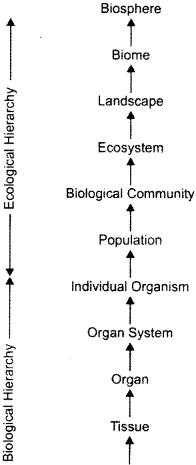
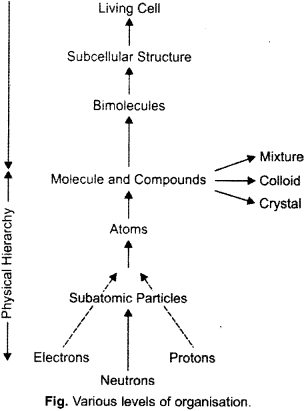
The non-living objects occur as molecules and compounds which are found as mixture, colloids and crystals. They are formed of atoms, atoms are formed of subatomic particles, which are ^ composed of electrons, protons and neutrons the lowest structures.
In living organisation, the molecules and g compounds polymerise and aggregate to form o’ biomolecules. The different biomolecules aggregate and organise to form different subcellular structures (= organelles) which together constitute the first living component the cell (individual unicellular organism). The cells may be held together to form tissue and different tissues together form organ.
The different organs constitute a organ system § and different organ systems form a multicellular ± complex whole Called individual organism the basic unit of ecology. if An aggregation of individual of same species is m called population. The assemblage of population of different species present is an area is called Biological Community.
The different biological communities and the physical environment both get integrated to form a self-sufficient, self-regulated fragment of nature, called ecosystem.
The different ecosystems characterised by specific climatic zone, form a major category of regional gecological organisation called Biome. Biomes are of two types-terrestrial and aquatic.
(b) One major cause of variation in nature is s environment. The environment by its components a. the temperature, light, nutrition, water and medicine bring about non-inheritable changes called modification or acquired characters. These variations affect the somatic or body cells of the organism.
(c) (i) In apes, incisors are large whereas in humans incisors are small.
(ii) Canines are large and projecting in apes while in humans canines do not project beyond the level of other teeth.
Section-B
(Answer any two questions)
Question 5.
(a) Give a graphic representation of the C3 cycle. [4]
(b) Discuss the role of cambium in secondary growth of dicot stems. [4]
(c) State two advantages of vegetative propagation. [2]
Answer:
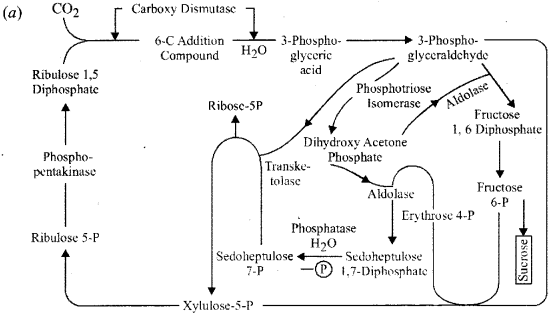
(b) Secondary growth is the characteristic of dicot stem because of the presence of open vascular bundles in stem — Activity of the Cambium :
(i) Formation of cambium ring: The vascular bundles of a dicot stem have strips of cambium in-between xylem and phloem which are known as intrafascicular cambium. During secondary growth, the cells of medullary rays at the level of intrafascicular cambium become meristematic activity and form strips of cambium called interfascicular cambium. The intra and interfascicular cambium join to form a complete ring called cambial ring or phellogen. The cells of vascular cambium are of two types, elongated spindle-shaped fusiform initials and shorter isodiametric ray initials. Both appear rectangular in TS. Ray initials give rise to vascular rays. The activity of cambial ring gives rise to secondary growth.’
(ii) Formation of secondary tissues : The fusiform cell of cambial ring becomes active and starts cutting off new cells. The cells cut off on the outer side get differentiated into secondary phloem and are called secondary phloem. The cells cut off on the inner side form the elements of xylem which constitute secondary xylem. The secondary phloem consists of sieve tubes, companion cells, phloem fibres and phloem parenchyma. Secondary xylem consists of pitted vessels, tracheids, xylem fibres, xylem parenchyma.
The cells of vascular cambium are of two types, elongated spindle-shaped fusiform initials and shorter isodiametric ray initials. Both appear rectangular in TS. Ray initials give rise to
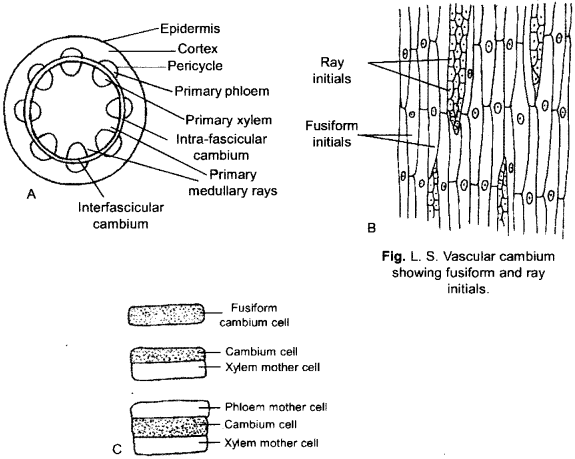
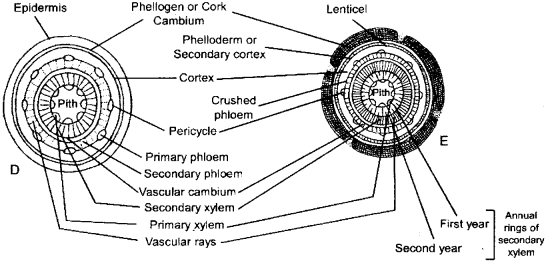
Fig. A, Complete ring of vascular cambium formed by strips of intrafascicular cambium and interfascicular cambium; B, L.S. Vascular cambium showing fusiform and ray initials; C, formation of secondary vascular tissue mother cells; D, the beginning of secondary growth (mostly made-up of secondary vascular tissues) of dicot stem (diagrammatic); E, two-year stage of secondary growth of a dicot stem.
(iii) Secondary medullary rays: Ray initial cells of cambium form radially elongated narrow bands of living parenchyma cells passing through secondary xylem and secondary phloem and are called secondary medullary rays. The part of ray in secondary xylem is called xylem ray and the part present in secondary phloem is called phloem ray. These provide radial conduction of food from the phloem and water, mineral salts from xylem.
(iv) Annual rings : Activity of cambium is not uniform in those plants which grow in the regions where favourable climatic conditions (spring or rainy season) alternate regularly with unfavourable climatic conditions (cold winter or dry hot summer). In temperate climates, cambium becomes more active in spring and forms greater number of vessels with wider cavities while in winter it becomes less active and forms narrower and smaller vessels. The wood formed in the spring is called spring wood and that formed in dry summer or cold winter, autumn wood. These two woods appear together in the form of a concentric ring, in the transverse section of the trunk and this is known as annual ring i.e., the total wood (secondary xylem) produced in a year. The growth of successive years appears in the form of concentric or annual rings, each annual ring representing the year’s growth. The age of the plant can approximately be determined by counting the number of annual rings (Dendrochronology).
(c) Advantages of Vegetative Propagation :
(i) It is the only known method of multiplication in seedless varieties and species, eg., Banana, Sugarcane.
(ii) It is a quick method of multiplication.
(iii) It helps in rapid spread of plant over an area.
(iv) Good qualities of the race or variety can be preserved indefinitely.
Question 6.
(a) Explain the role of hormones during the menstrual cycle.
(b) Give four adaptations shown by flowers pollinated by wind.
(c) Give two differences between heartwood and sapwood.
Answer:
(a) Menstruation phase occurs when the concentration of ovarian and gonadotropin hormones is low in blood. Reduced concentration of these hormones stimulates the hypothalamus to produce GnRH (gonadotropin-releasing hormone). It activates anterior pituitary to gonadotropin hormones.
(i) Pituitary hormones : The pituitary hormones secreted during menstrual cycle are FSH and LH. The FSH (Follicular stimulating hormone) stimulates the growth of primary oocyte into secondary oocyte and the Graafian follicle.
The maximum level of LH (Luteinising hormone) induces rupture of Graafian follicle to release ovum containing secondary oocyte (ovulation).
(ii) Ovarian hormones : The FSH secretion by pituitary gland stimulates the ovarian follicles to secrete oestrogen. Oestrogen stimulates the proliferation of endometrium of the uterine wall. After ovulation, the remaining cells of ovarian follicle are stimulated by LH to develop corpus luteum which secretes large amount of progesterone. Progesterone is essential for maintenance of endometrium, for implantation of fertilised ovum and other events of pregnancy. .
(b) Adaptation for wind-pollination or anemophily :
(i) Flowers small inconspicuous.
(ii) Calyx, corolla reduced or absent.
(iii) Flowers colourless, nectarless or odourless.
(iv) Flowers produced above and before foliage, in case of unisexual flowers, male flowers are abundant to compensate loss and to ensure the pollination.
(v) Stamens and stigma (feathery) exserted and well exposed.
(vi) Pollen grains, light, small, dusty, non-sticky or winged (Pinus).
(vii) Pollen grains dry and unwettable, e.g., maize, grasses, Urtica.
(viii) Number of ovules very less, often single. (any four points)
(c) Differences between Sapwood or Alburnum and Heartwood or Duramen
| Sapwood (Alburnum) | Heartwood (Duramen) |
| 1. It is outer wood of an old stem. 2. It is light coloured. 3. Living cells are present. 4. Sapwood is the functional part of the secondary xylem or wood. | 1. It is the central wood of an old stem. 2. Heartwood is dark coloured. 3. Living cells are absent. 4. Heartwood is the non-functional part of secondary xylem. (any two points) |
Question 7.
(a) Explain chemiosmotic hypothesis for ATP synthesis. [4]
(b) Draw a neat labelled diagram of the vertical section of a monocot leaf. [4]
(c) Mention any two functions of the human placenta. [2]
Answer:
(a) Chemiosmotic hypothesis (Oxidative Phosphorylation) : It is the synthesis of energy-rich ATP from ADP and inorganic phosphate, that is connected to oxidation of reduced coenzymes produced in cellular respiration. ATP synthesis is explained by chemiosmotic (coupling) theory given by British biochemist Peter Mitchell in 1961 (Nobel Prize in 1978). It is applicable to ATP synthesis both in respiration and photosynthesis. According to chemiosmotic theory, the energy liberated during electron transport performs the osmotic work of accumulating H+ ions, conserving energy in building a proton gradient or proton motive force (PMF) which is used to build ATP from ADP and inorganic phosphate.
(i) Development of Proton Gradient or Proton Motive Force : Oxidation of reduced coenzymes releases both electrons and protons. Electrons pass over an electron transport chain releasing energy at every step. The energy is employed in pushing not only the protons of their coenzymes but also other protons from mitochondrial matrix to the intermembrane space or outer mitochondrial chamber. Oxidation of one NADH (+H+) is linked to pushing of three pairs of protons into outer chamber while oxidation of FADH2 is linked to sending out two pairs of protons. As a result, proton concentration increases in the outer chamber (Fig.). The difference in the proton concentration on the two sides of a system is called proton gradient. pH of the outer chamber decreases as compared to mitochondrial matrix.
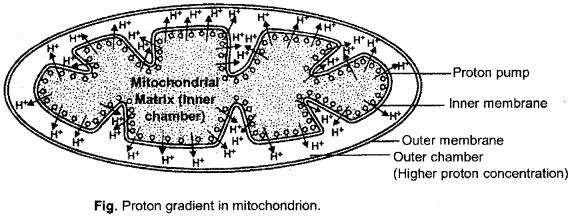
An electrochemical potential difference occurs across the inner mitochondrial membrane that tends to push protons back towards the matrix. It is called proton motive force (PMF).
(ii) Proton Driven ATP Synthesis : Proton gradient or proton motive force tends to push the protons from outer mitochondrial chamber towards the mitochondrial matrix through the inner membrane. However, inner membrane is permeable to protons only in the region of Fo or bases of elementary particles (FQ – F i particles). They function as proton tunnels or channels while F i head piece has enzyme ATP-ase that catalyses ATP synthesis. Two protons are required for synthesis of one molecule of ATP. They knock out one oxygen of inorganic phosphate and convert the latter into active phosphate (energy rich phosphate).
The latter immediately combines with ADP to form ATP or ADP-P. Since NADH (+H+) drives out 3 pairs of protons to outer chamber, its oxidation is linked to synthesis of 3 ATP molecules. Similarly, oxidation of FADH2 that causes pumping of two pairs of protons forms 2 ATP molecules. ATP molecules synthesised inside mitochondria come out of the latter through facilitated diffusion across inner membrane and diffusion across outer membrane.
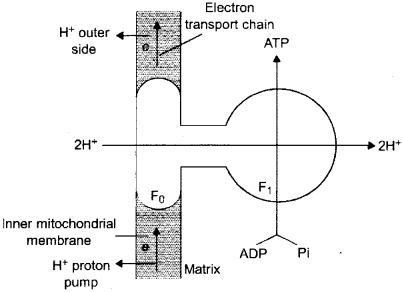
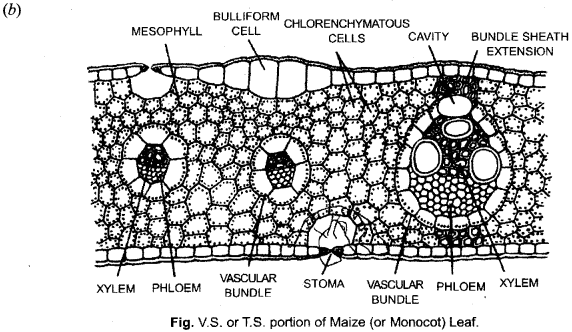
(c) (i) Placenta helps in exchange of gases CO2 and O2 between foetus and mother’s blood.
(ii) It provides nutrition to the developing foetus from mother’s blood.
(iii) It helps in excretion of urea, from foetus blood into mother’s blood.
(iv) It acts as endocrine gland producing hormones, to maintain pregnancy and helps in parturition and prepare mammary glands for lactation.
(any two points)
Question 8.
(a) Explain the process of sex determination in honey bees. [4]
(b) Define complete linkage. Give an example of a cross, showing complete linkage. [4]
(c) Write a short note on Multiple Ovulation Embryo Transfer Technology. [2]
Answer:
(a) Sex-determination in honeybee involves haplodiploidy.
Haplodiploidy : It is a type of sex determination in which the male is haploid while the female is diploid. Haplodiploidy occurs in some insects like bees, ants and wasps. Male insects are haploid because they develop parthenogenetically from unfertilized eggs. Meiosis does not occur during the formation of sperms. Females grow from fertilized eggs and are hence diploid. Queen Bee picks up all the sperms from the drone during nuptial flight and stores the same in her seminal vesicle. It does not fertilise the eggs which are to develop into males or drones. Workers and future Queen Bee develop from fertilised eggs and are sexually female. The difference between them lies in the nourishment they receive (royal jelly for queen and bee bread for workers).
(b) Complete linkage : It is a type of inheritance in which only the parental types appear in the progeny and the cross overs or recombinant types are absent. Here, the genes for the characters are linked genes and occur closely on the same chromosome and do not show independent assortment. Crossing over is absent between the linked genes. Following cross, shows complete linkage.

The F females of above cross are crossed with homozygous recessive males. The ratio comes out to be 9 : 1 : 1 : 8. The two genes did not segregate independently.
(c) Multiple Ovulation Embryo Transfer Technology (MOET) is a programme for herd improvement. Different steps in this method are :
(i) A cow is administered hormone (like FSH) to induce follicular maturation and super-ovulation, i.e., 6-8 eggs in one cycle.
(ii) The cow is either mated with the selected superior bull or artificially inseminated.
(iii) The fertilised eggs at 8-32 cell stages are recovered non-surgically and transferred to surrogate mothers.
(iv) Now, the genetic mother is available for another round of super-ovulation.
(v) This technology has been used for cattle, sheep, rabbit, buffalo, mare etc.
(vi) High milk-yielding breeds of females and high quality meat-lean meat, with little fat yielding bulls have been bred successfully to obtain better breed and increase the herd size in short time.
Question 9.
(a) Give an account of artificial chromosomes in transfer of genetic material. [4]
(b) Mention any four methods involved in the treatment of cancer. [4]
(c) What is RNA inteiference? Give any one application of RNA interference. [2]
Answer:
(a) Artificial chromosomes used for transfer of genetic materials are :
(i) YAC Vectors. Yeast artificial chromosomes (YAC) have been developed as high capacity vector which can clone very large DNA segment of about 1 Mb in length. It is maintained as a separate chromosome in the cell. It has been used for physical mapping of human chromosome in ‘Human Genome Project’. The pYAC plasmid contains the E. coli origin of replication (oriE) and a selectable marker (ampr), a yeast DNA sequence, genes each for uracil biosynthesis pathway (URA3) providing centromeric function (CEN), automatic replication sequence (ARS), tryptophan synthesis pathway (TRP) and telomeric (T) sequence (Fig.). There are recognition sites for restriction enzymes such as Smal and BamHI.
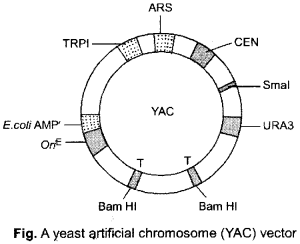
(a) BAC Vectors : Bacterial artificial chromosomes (BAC) are used as cloning vectors. BAC are constructed by using Fertility of F factors (present on F plasmid) of E. coli. BAC vectors contain ori gene, a gene for maintenance of F factor, a selectable marker (an antibiotic resistance gene) and many restriction sites for insertion of foreign DNA. The upper limit of foreign DNA to be inserted in BAC is about 300-3500 kb. It is used in geneome sequencing projects.
(b) Treatment of Cancer : It depends upon the type of cancer. There are four types of cancer treatment strategies which are used singly or in combination.
(i) Surgery : The tumour is removed surgically. However, as malignant tumour has migrating cells, the latter cannot be removed. Therefore, surgical removal of a malignant or cancerous tumour is never completely successful. Certain tumours are, however, not accessible to surgical excision. In some of these laser microsurgery has been used successfully.
(ii) Radiation Therapy : Cancer cells are undifferentiated dividing cells. They are more easily damaged by radiations than the other differentiated body cells. Radon (Rn-220), Iodine (1-131) and cobalt (Co-60) are radioisotopes commonly used in radiotherapy. However, some harmful changes do occur to normal tissues around the tumour mass.
(iii) Chemotherapy : It is the use of cytotoxic drugs often along with other types of therapies. The common drugs are cisplatin and fluorouracil, nitrosoureas, vincristine and vinblastin (from Catharanthus roseus in leukaemia), taxol (from Taxus baccata) and tetrathiomolybdate. Cytotoxic drugs, however, have a number of side effects.
(iv) Immunotherapy : It is strengthening of anticancer immunological defence mechanism of the body because tumour cells avoid detection and destruction by immune system. For this the patients are given biological response modifiers such as a-interferon. They activate the immune system which helps in destroying tumour cells. Monoclonal antibodies with attached radioisotopes combine immunotherapy with radiotherapy. Another approach is to develop vaccines against cancers. Bone marrow transplant is used in case of leukaemia.
(c) RNA interference : It is a method of cellular defence which takes place in all eukaryotic organisms. It involves silencing of a specific w-RNA due to the complementary <A-RNA molecule that binds to and prevents translation of w-RNA (silencing).
Application of RNA interference : Several nematodes parasitise a wide variety of plants and animals. For example a nematode Meloidegyne incognitia infects the roots of tobacco plants and reduces the yield. RNA interference, prevents this infestation.
Question 10.
(a) What is Integrated Pest Management?
(b) Explain the structure of a typical antibody molecule.
(c) Why are bio-fertilizers preferred over chemical fertilizers?
Answer:
(a) Integrated Pest Management or IPM is a systematic plan to manage crops using different pest control tactics to keep pests below the levels where they can cause economic damage, with least risk to environment. Management does not mean eradicating pests. It means finding tactics that are effective and economical and that keep environmental damage to a minimum.
There is a key belief that the more variety a landscape has, the more sustainable it is. The organic farmer wants to create a system where the insects that are sometimes called “pests” are not eradiated but instead are kept at manageable level by a complex system of checks and balance within a living and vibrant ecosystem. The eradication of pests is not only possible but also undesirable keeping in view the survival of predatory and parasitic interests. Thus, the use of biocontrol measures will greatly reduce our dependence upon toxic chemicals and pesticides.
The four main groups of pests are weeds; invertebrates (insects, mites, ticks, spiders etc); disease agents or pathogens (bacteria, fungi, viruses, nematodes etc); and vertebrates (birds, reptiles, rodents).
Biocontrol agents and bioherbicides are the two major approaches under IPM.
Biocontrol is defined as controlling plant diseases and pests using biological methods. The biocontrol depends upon natural predation, e.g., ladybirds and Dragonflies are used to get rid of aphid and mosquitoes. Spores of Bacillus thuringiensis are used to control butterfly caterpillars. The fungus Trichoderma species are effective in control several plant pathogens.
Nucleopolyhedro viruses are pathogens that attack insects and other arthropods. Bioherbicides are the organisms and their extracts which destroy weeds without harming crop plants. They are of three types-predator herbivore (cochineal insect, a herbivore on Opuntia weed), smoother crops (Soyabeans, barley etc.) and mycoherbicides (Phytophthora palmivora does not allow Milk weed vine to grow in citrus orchards).
(b) Structure of an Antibody (Gk. anri-against, body-body) Antibody is a glycoprotein, called immunoglobulin, which have a specific amino acid sequences by which they can interact with specific antigens. Antibodies form 20% of the plasma proteins. Each antibody has a combination of at least 2 light (L) and 2 heavy (H) polypeptide chains. The heavy chains has larger number of amino acids while lighter chain has smaller number of them. Usually, the polypeptides form a Y-shaped configuration. The stem of Y is exclusively formed by heavy chains. In the arms of Y, both light and heavy chains occur parallel to each other except for antigen binding sites. Attachments and bendings occur by means of disulphide bonds (—S—S—). In certain immunoglobulins the number of chain pairs can be JO. An antibody has a variable portion in the arms. It is called V-region or antigen-binding fragment, Fab. The remainder of the antibody is called constant portion or crystalline fragment, Fc.
Most of the antibodies function as monomers. A few such as IgA, IgM can occur both as monomers and polymers.
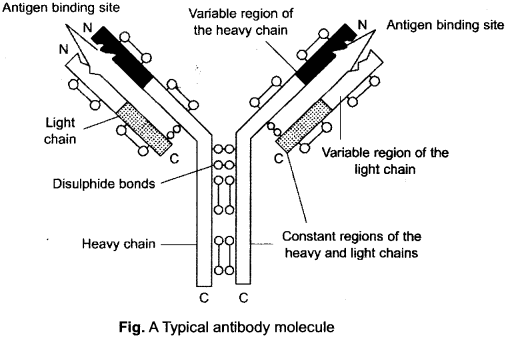
Fig. A Typical antibody molecule
(c) Biofertilizers are preferred to chemical fertilizers due to following advantages :
(i) Decomposition products of biofertilizers help to bring mineral constituents of soil into solution.
(ii They improve physiochemical properties of soil such as cation exchange and buffering action.
(iii) They modify the physical properties like granulation of the soil and increases permeability and moisture-holding capacity of soil.
(iv) They are economically cheaper than chemical fertilizers.
(v) Biofertilizers do not cause any harm to environment while many chemical fertilizers are non-degradable and cause soil and water pollution.
(vi) They provide food for soil microbes and thus enhance microbial activities.
